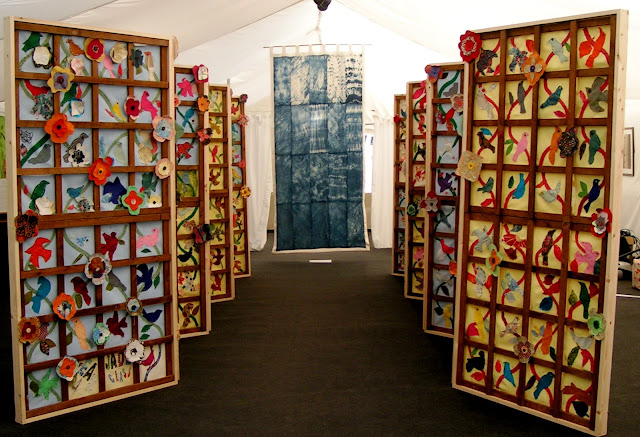River & Cloth. Textiles Heritage Project, London Borough of Merton.
Madeline created and delivered a four-month programme of workshops and creative art activities in response to the work of William Morris for the River & Cloth project from 2009-2010. The aim of River & Cloth was to encourage people living and working in Merton to engage with the history of their local area, in particular the rich textile industry, which took place there from the middle ages until mid 20th century. Specifically, Madeline designed an embroidery workshop which introduced participants to the textiles of William Morris, and enabled them to learn traditional techniques to create their own individual works, which then became part of a larger collective 'tapestry', based on Morris' famous 'Trellis' design. This was a very imaginative approach to the project - from the beginning, each participant was aware that their own contribution was also part of a larger art work which would showcase the achievements of the wider community. The final outcome of the project was an exhibition at Merton Abbey Mills, one of the key sites of Merton's textile heritage. The 'trellis' tapestry was displayed in a series of garden trellises, which were joined together and provided an eye catching and colourful centrepiece to the exhibition.
Trellis Wallpaper
The Trellis is widely regarded as William Morris’s first wallpaper design. The pattern is thought to have been inspired by the gardens at Red House, which were organised on a medieval plan with square flowerbeds enclosed by trellises for the roses. The design of the trellis has a mediaeval character – the motifs are drawn in a slightly naïve style reminiscent of the woodcut images found in 16th- and 17th-century herbals (books describing and illustrating plants and their uses). Morris collected these early printed books and often took his inspiration from their simple and stylised illustrations. The patterns he created were usually entitled with the names of the flowers that they depicted such as 'Chrysanthemum', 'Jasmine', 'Acanthus', and 'Sunflower'. In effect, Morris took the natural forms that he found outside in the woods and meadows and used them to decorate the inside of people’s homes.
In the trellis, the image of the climbing roses and their prominent thorns convey the theme found in many of Morris’s poetic works (including The Defence of Guenevere), which is the close relationship between beauty and danger. The rose is "a domesticated plant that is still very much part of the natural world of display and defence, desire and threat"
Likewise, if you look closely, you can also see the mayflies Morris has included in the picture (one is visible in the illustration of the trellis on the previous page, in first coloured block from the top), symbolizing the delicacy and transitory nature of life, while the birds give the design energy and vitality. Again, as in Morris's poems, this design "implies that no easy distinctions can be made among wild, domesticated, and human nature, house, garden, and beyond". Everything is as interwoven as the image itself.
While many of William Morris' later wallpaper designs eclipsed the trellis in their complexity, it remained a favourite of Morris’ throughout his life. Trellis was Morris's choice as the wallpaper for his own bedroom at Kelmscott house, which was his home in Hammersmith, London, for the last 18 years of this life.
















No comments:
Post a Comment